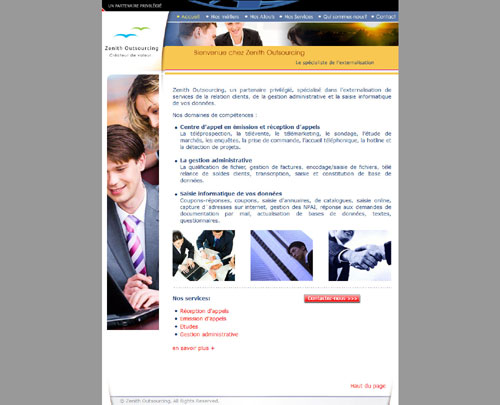
Creating effective web interfaces requires good knowledge of user habits to facilitate site navigation, a good marketing approach to promote the fulfillment of goals, good technical knowledge to optimize the development and, last is not least, a good dose of creativity to produce a unique design which matches the positioning and image of your company. We build, in collaboration with you and your communication agency, a web presence that takes into account all the details that promote success.Regardless of the advent of search engines, it is still often the main point of entry for internet websites. Therefore it is one of the most important pages that will determine the success or failure of a visit. It is recommended to put in a sufficient amount effort to guarantee a good usage.
1. Chose and display a direct tagline
2. Offer recent examples of content
3. Highlight the principal options and tasks
4. Do not overload the page without real reason
Navigational Links
Having easy-to-use navigation is important for any web site. This has a considerable impact on the ease of access to content. If the user does not understand or does not clearly see the sections they have access to, it is evident that site navigation will be penalized.
Links
This axis is about links presented in a text manner on pages on the internet. This can be contextual links or secondary menus. These links allow users to develop an idea of the information value of a common page as well the possible destinations deriving from this page. They have great influence on the internal navigation of a section.
9. Follow web standards for text links
10. The titles of the pages and links must be logical
11. The presentation of links must be related to what they point towards
12. Identify outbound links
Navigation and orientation
This axis concerns more general aspects of navigation and aims to evaluate the quality of orientation guides provided to users. Besides menus and links, there are other parameters to take into account to evaluate ease of navigation. In this axis, we approach criterions of a constant interface, common position identification, pop-up abuse and the help section.
13. Present the common position to the user
14. Returning to the homepage should be easy
14. Sections help site navigation
16. Avoid using excessive pop-ups
17. The site design should be constant throughout the visit
Visual aspects and Legibility
This axis concerns legibility of information present on the site. The previous axes were concerned with information access, but it is evident that the presentation of the information plays an equally important role for the website usability. The users must be capable of easily reading and visually identify the different compositions of a web page.
18. Allow easy print of the content on the pages
19. Limit the length of text lines
20. A strong contrast maximizes the legibility
21. Avoid superfluous animations
22. Avoid the use of frames and offer a HTML version for a flash website
23. Add a favicone
Error Management
The last aspect discussed in this guide concerns error management. A site that has errors will lose in terms of visits and credibility. Moreover, an important point from this axis concerns the recuperation and prevention of errors when online forms are filled out. This is effectively a key point of all sites wanting to integrate with users whether it is for newsletter inscriptions or for an online sales order.
24. Pay attention to the use of plug-ins
25. Have a personalized 404 error page
26. Manage the possible errors in the forms
27. Ensure the site is multiplatform

1 comment. Leave new